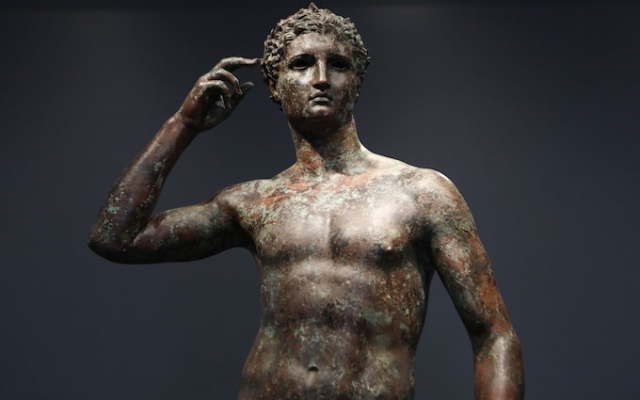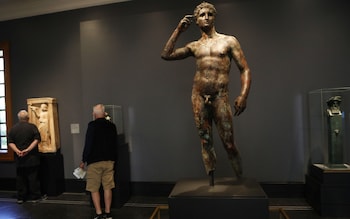 Known as “The Victorious Youth,” the 5-foot-tall piece is attributed to Lysippos, the personal sculptor of Alexander the Great. Photo: Mario Tama/Getty Images
Known as “The Victorious Youth,” the 5-foot-tall piece is attributed to Lysippos, the personal sculptor of Alexander the Great. Photo: Mario Tama/Getty Images
According to a decision of the European Court of Human Rights (ECHR), the Getty Trust in the United States must return to Italy one of the most valuable works of its collection — an ancient Greek bronze depicting a young man.
In a unanimous decision, a court in Strasbourg ruled that the J Paul Getty Trust acted with «negligence or bad faith» when it bought the statue in 1977 for $4 million.
The life-size bronze, known as the «Victorious Youth», was pulled up in fishing nets off the coast of central Italy in 1964.
Also known as the «Sportsman of Fano» after the name of the town near where it was discovered , it is one of the very few life-size Greek bronze statues surviving from antiquity.
It is a major attraction at the Getty Villa Museum in Malibu in California, where it has been on display since its purchase.
The ECHR said Italy has every right to demand the return of works of art that date from 300 to 100 BC. e.
Italy issued a confiscation order for the statue, which the Getty Trust appealed.
“The court held that, in particular, because of the Getty Trust's negligence or bad faith in purchasing the statue, despite being aware of the claims of the Italian State and their efforts to recover it, the order of confiscation was proportionate to the purpose of securing the return of the object which was part of Italy's cultural heritage,» the decision said.
Called the «Getty Bronze,» the 5-foot-tall statue depicts a young athlete raising his right hand to an olive wreath around his head. . Some experts attribute this work to Lysippos, the personal sculptor of Alexander the Great.
 The sculpture is the main attraction of the Getty Villa Museum in Malibu, California. Photo: Mario Tama/Getty Images
The sculpture is the main attraction of the Getty Villa Museum in Malibu, California. Photo: Mario Tama/Getty Images
The bronze is believed to have been captured by the Romans after their conquest of Greece. He ended up on the seabed after the ship taking him to Italy capsized and sank.
After being caught in the nets of Italian fishermen fishing in international waters in 1964, it was reportedly hidden in a cabbage patch to avoid detection, and even in a priest's bath before with which he was sold and taken away. Italy.
It was put up for auction in Munich by a company from Liechtenstein. It was purchased by the Getty Trust, shipped to the United States in 1977, and arrived at the Getty Villa in Malibu in 1978.
The Getty Trust has always maintained that it acquired the work of art in good faith.
>
Subsequent Italian governments have said it was taken out of the country illegally and have been trying to get it back for years.
«A clear decision»
Gennaro Sangiuliano, the culture minister, welcomed the ECHR's decision, saying: «The court in Strasbourg recognized Italy's rights with its unequivocal decision.»
The judge was very clear about the identity of the statue, which was found in waters off the coast of the Marche region and then taken abroad. We will continue with renewed determination our efforts to return the statue to Italy as quickly as possible.»
In 2010, an Italian court in Pesaro in the central Marche region ordered the confiscation and return of the statue, ruling that it had been taken by an Italian-flagged fishing boat .
The decision was upheld by Italy's High Court in 2018, but the Getty Trust appealed on points of law.
The trust argues that Italy is not eligible to claim the bronze because it is Greek, not Italian. They also say that it was found in international waters and that it is not part of Italy's cultural heritage.
In 2019, Italy's Supreme Court ordered the return of the statue, noting that it should be considered part of the Italian cultural heritage because there was a «continuum between the Greek civilization that spread into Italian territory and the subsequent Roman cultural experience.»
The ECHR's decision on Thursday was a chamber decision. Both sides now have three months to request that the case be heard by the court's Grand Chamber for a final decision.
In response to the court's decision, the Getty Trust repeated its argument that the classical statue is neither a work Italian sculptor and not found in Italian waters.
“We believe that the Getty's nearly 50-year public ownership of a work of art that was not created by an Italian artist and was not found on Italian soil is appropriate, ethical and consistent American and international law,” the institution said in a statement sent to The Telegraph.
“Getty is carefully considering the possibility of requesting a review by the Grand Chamber of the ECHR. If necessary, Getty will continue to defend its ownership of the statue in all appropriate courts.»























































Свежие комментарии